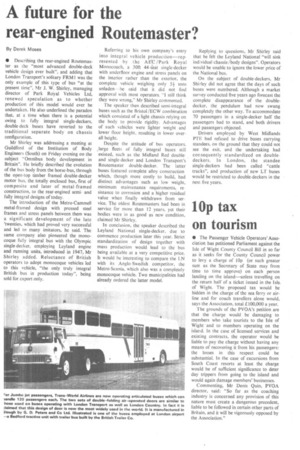A future for the rear-engined Routemaster?
Page 57

If you've noticed an error in this article please click here to report it so we can fix it.
By Derek Moses
• Describing the rear-engined Routemaster as the "most advanced double-deck vehicle design ever built", and adding that London Transport's solitary FRM1 was the only example of this type of bus "at the present time", Mr J. W. Shirley, managing director of Park Royal Vehicles Ltd, renewed speculation as to whether production of this model would ever be undertaken. He also underlined the paradox that, at a time when there is a potential swing to fully integral single-deckers, double-deck buses have reverted to the traditional separate body on chassis configuration.
Mr Shirley was addressing a meeting at Guildford of the Institution of Body Engineers (South) on Friday evening on the subject -Omnibus body development in Britain". He briefly described the evolution of the bus body from the horse-bus, through the open-top timber framed double-decker motor bus, the totally enclosed bus, first of composite and later of metal-framed construction, to the rear-engined semiand fully integral designs of today.
The introduction of the Metro-Cammell metal-framed design with pressed steel frames and stress panels between them was a significant development of the late 'twenties, which had proved very successful and led to many imitators, he said. The same company also pioneered the monocoque fully integral bus with the Olympic single-decker, employing Leyland engine and running units, introduced in 1947, Mr Shirley added. Reluctance of British operators to adopt monocoque vehicles led to this vehicle, "the only truly integral British bus in production today", being sold for export only.
Referring to his own company's entry into integral vehicle production--represented by the AEC /Park Royal Monocoach, a 30ft 44-eat single-decker with underfloor engine and stress panels on the interior rather than the exterior, the complete vehicle weighing only 5; tons unladen—he said that it did not find approval with most operators. -1 still think they were wrong," Mr Shirley commented.
The speaker then described semi-integral buses such as the Bristol /ECW combination which consisted of a light chassis relying on the body to provide rigidity. Advantages of such vehicles were lighter weight and lower floor height, resulting in lower overall height.
Despite the attitude of bus operators, \large fleets of Fully integral buses still existed, such as the Midland Red doubleand single-decker and London Transport's Routemaster double-decker. The latter buses featured complete alloy construction which, though more costly to build, had distinct advantages such as low weight, minimum maintenance requirements, resistance to corrosion and a higher residual value when finally withdrawn from service. The oldest Routemasters had been in service for more than 12 years, yet their bodies were in as good as new condition, claimed Mr Shirley.
In conclusion, the speaker described the Leyland National single-decker, due to commence production later this year. Strict standardization of design together with mass production would lead to the bus being available at a very competitive price. It would be interesting to compare the LN with its Anglo-Swedish competitor, the Metro-Scania. which also was a completely monocoque vehicle. Two municipalities had already ordered the latter model. Replying to questions, Mr Shirley said that he felt the Leyland National "will sink indtvidual chassis /body designs". Operators would be unable to ignore the lower price of the National bus.
On the subject of double-deckers, Mr Shirley did not agree that the days of such buses were numbered. Although a market survey conducted five years ago forecast the complete disappearance of the doubledecker. the pendulum had now swung completely the other way. To accommodate 70 passengers in a single-decker half the passengers had to stand, and both drivers and passengers objected.
Drivers employed by West Midlands PTE had refused to drive buses carrying standees, on the ground that they could not see the exit, and the undertaking had consequently standardized on doubledeckers. In London, the standee single-deckers had been called "cattle trucks", and production of new LT buses would be restricted to double-deckers in the next five years.






































































































































































